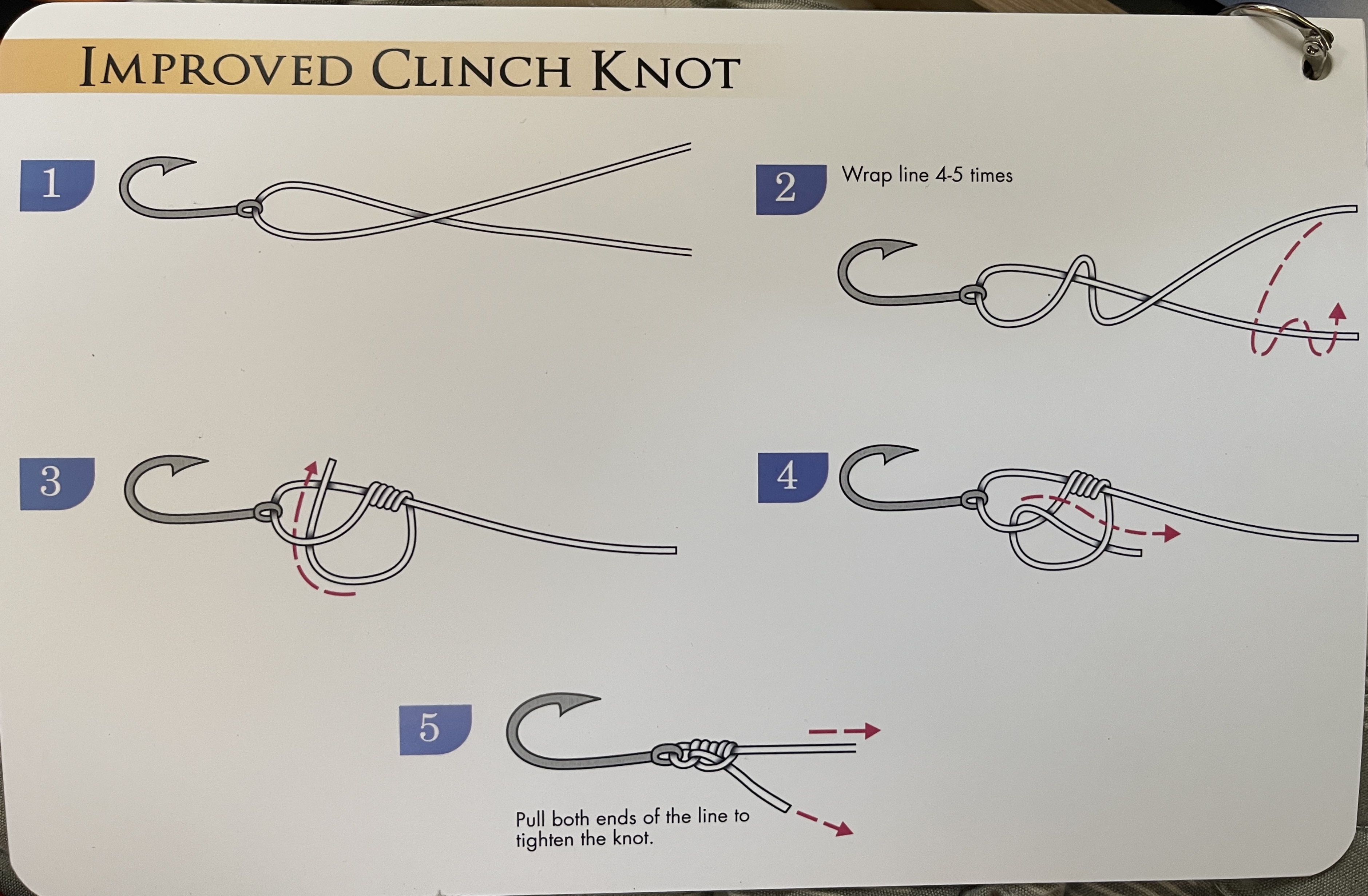
Summary
The Improved Clinch Knot is a popular fishing knot used for securing a fishing line to a hook, lure, or swivel. Here’s a breakdown of its uses and benefits:
Reliability
The Improved Clinch Knot is a reliable and beginner-friendly knot, making it an excellent choice for most recreational anglers.
Primary Uses of an Improved Clinch Knot
-
Attaching a Hook, Lure, or Swivel:
- This knot is commonly used to tie a fishing line directly to the eye of a hook, lure, or swivel.
- It’s particularly popular for freshwater fishing and light saltwater applications.
-
Securing Terminal Tackle:
- Ideal for attaching terminal tackle, such as jigs, spinners, or crankbaits.
-
Tying to Monofilament or Fluorocarbon:
- Best suited for monofilament and fluorocarbon lines because of its ability to grip tightly.
Why Use the Improved Clinch Knot?
-
Strength:
- The “improved” aspect comes from passing the tag end through the loop at the end before tightening, increasing knot strength.
-
Ease of Tying:
- Simple to tie, even for beginners, and effective for most fishing situations.
-
Streamlined Design:
- The finished knot is small and neat, making it less likely to snag or tangle.
-
Versatility:
- Works well in a variety of fishing scenarios, especially when using light to medium tackle.
How to Tie an Improved Clinch Knot
-
Pass the Line Through the Eye:
- Thread the line through the eye of the hook or lure.
-
Wrap the Line:
- Wrap the tag end around the standing line 5–7 times.
-
Thread Through the Loop:
- Pass the tag end through the small loop near the eye.
-
Improved Step:
- Take the tag end and pass it through the large loop you just created.
-
Tighten the Knot:
- Moisten the knot with water or saliva to reduce friction, then pull the standing line to tighten the knot.
-
Trim the Tag End:
- Cut off any excess tag end close to the knot.
When to Use the Improved Clinch Knot
-
Light to Medium Line:
- Best suited for lines with a lower breaking strength (e.g., under 30 lbs). For heavier lines, the knot may lose efficiency.
-
Freshwater Fishing:
- Frequently used for bass, trout, and panfish fishing.
-
Calm Waters:
- Works well when not dealing with large, aggressive fish that may put extreme strain on the knot.
Limitations
-
Not Ideal for Braided Line:
- The knot may slip when used with slick braided fishing lines unless a drop of superglue is added or another knot is tied (like a Palomar Knot).
-
Strength Reduction:
- The knot reduces line strength slightly when improperly tied or over-tightened.
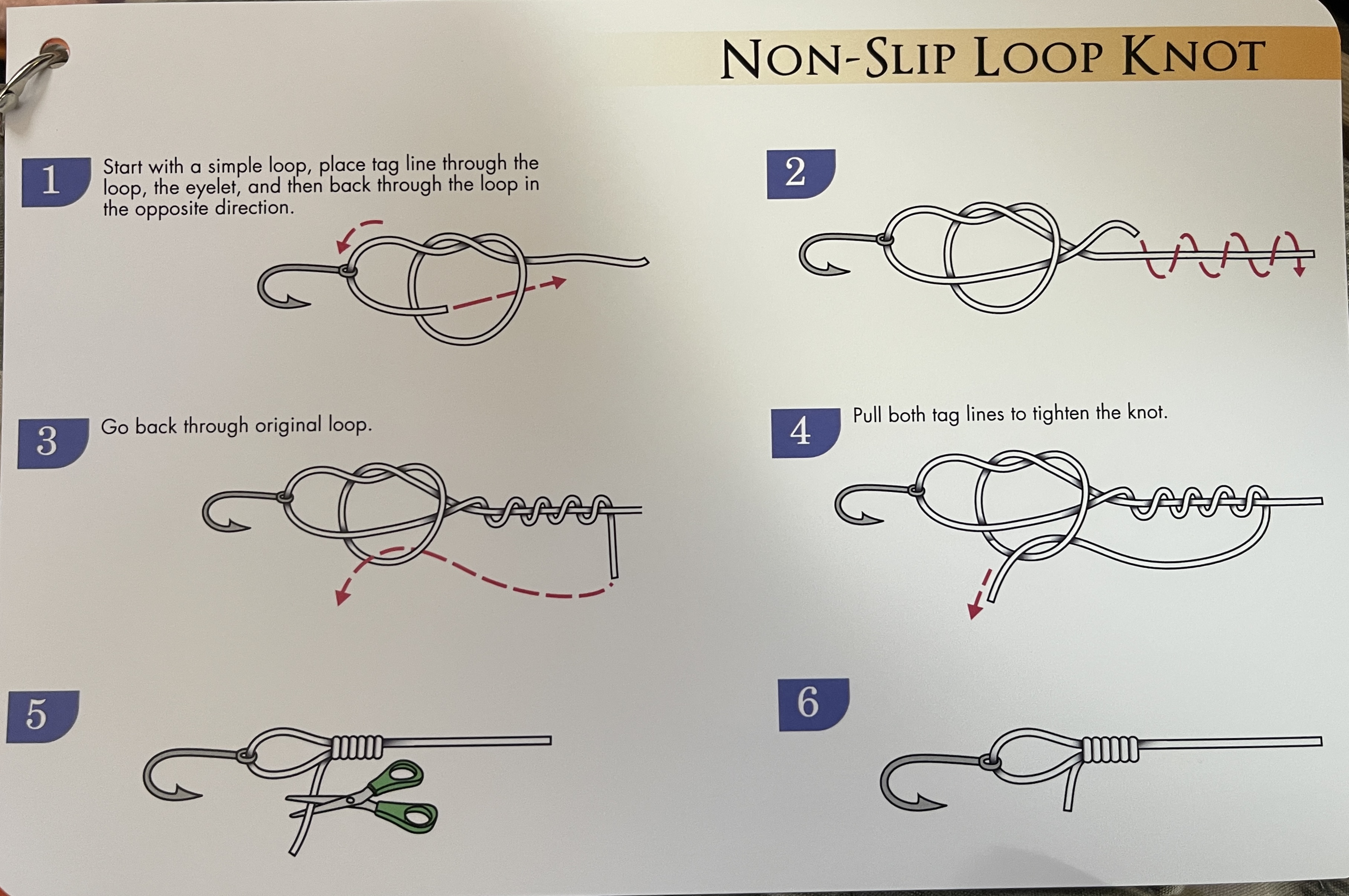
Summary
The Improved Clinch Knot is a popular fishing knot used for securing a fishing line to a hook, lure, or swivel. Here’s a breakdown of its uses and benefits:
Reliability
The Improved Clinch Knot is a reliable and beginner-friendly knot, making it an excellent choice for most recreational anglers.
Primary Uses of an Improved Clinch Knot
-
Attaching a Hook, Lure, or Swivel:
- This knot is commonly used to tie a fishing line directly to the eye of a hook, lure, or swivel.
- It’s particularly popular for freshwater fishing and light saltwater applications.
-
Securing Terminal Tackle:
- Ideal for attaching terminal tackle, such as jigs, spinners, or crankbaits.
-
Tying to Monofilament or Fluorocarbon:
- Best suited for monofilament and fluorocarbon lines because of its ability to grip tightly.
Why Use the Improved Clinch Knot?
-
Strength:
- The “improved” aspect comes from passing the tag end through the loop at the end before tightening, increasing knot strength.
-
Ease of Tying:
- Simple to tie, even for beginners, and effective for most fishing situations.
-
Streamlined Design:
- The finished knot is small and neat, making it less likely to snag or tangle.
- Works well in a variety of fishing scenarios, especially when using light to medium tackle.
- The finished knot is small and neat, making it less likely to snag or tangle.
How to Tie an Improved Clinch Knot
-
Pass the Line Through the Eye:
- Thread the line through the eye of the hook or lure.
-
Wrap the Line:
- Wrap the tag end around the standing line 5–7 times.
-
Thread Through the Loop:
- Pass the tag end through the small loop near the eye.
-
Improved Step:
- Take the tag end and pass it through the large loop you just created.
-
Tighten the Knot:
- Moisten the knot with water or saliva to reduce friction, then pull the standing line to tighten the knot.
-
Trim the Tag End:
- Cut off any excess tag end close to the knot.
When to Use the Improved Clinch Knot
-
Light to Medium Line:
- Best suited for lines with a lower breaking strength (e.g., under 30 lbs). For heavier lines, the knot may lose efficiency.
-
Freshwater Fishing:
- Frequently used for bass, trout, and panfish fishing.
-
Calm Waters:
- Works well when not dealing with large, aggressive fish that may put extreme strain on the knot.
Limitations
-
Not Ideal for Braided Line:
- The knot may slip when used with slick braided fishing lines unless a drop of superglue is added or another knot is tied (like a Palomar Knot).
-
Strength Reduction:
- The knot reduces line strength slightly when improperly tied or over-tightened.
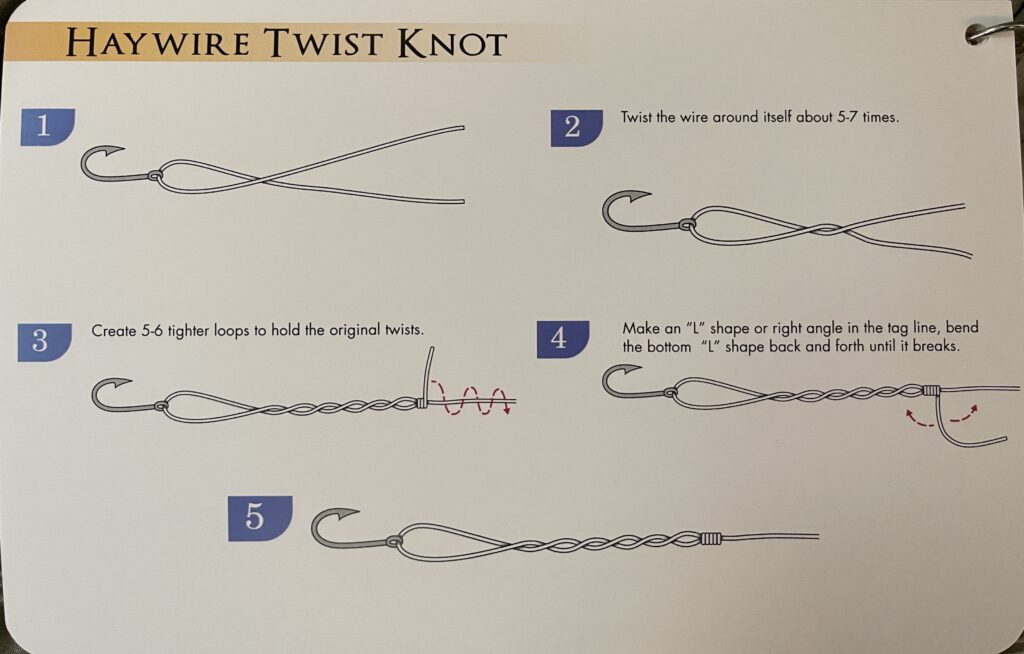
Summary
The Haywire Twist Knot is a specialized knot used primarily in saltwater fishing when working with single-strand wire leaders. This knot is not technically a “knot” but a twisting technique to securely attach hooks, swivels, or lures to wire, preventing the sharp teeth of certain fish (like mackerel or barracuda) from cutting through the line.
Essebtial Tool for Saltwater
The Haywire Twist Knot is an essential tool for saltwater anglers targeting toothy predators. It ensures durability, secure attachments, and confidence when fishing in tough conditions where fish can destroy weaker leader setups.
Primary Uses of the Haywire Twist Knot
-
Attaching Wire Leaders to Hooks, Lures, or Swivels:
- Ideal for connecting hooks, trolling lures, or artificial baits when using single-strand wire leaders in saltwater fishing.
-
Fishing for Toothy Predators:
- Essential when targeting sharp-toothed fish like:
- Barracuda
- Kingfish (King Mackerel)
- Wahoo
- Bluefish
- Sharks These fish can easily bite through monofilament or fluorocarbon leaders, making wire leaders and the Haywire Twist essential.
- Essential when targeting sharp-toothed fish like:
-
Trolling Applications:
- Commonly used in offshore trolling rigs where fish strike fast-moving baits, and durability is critical.
Why Use the Haywire Twist Knot?
-
Secure Hold:
- The twisting action locks the wire leader securely to the hook, swivel, or lure, ensuring it won’t slip or loosen under tension.
-
Durability with Wire:
- Specifically designed for single-strand wire, which can be difficult to knot traditionally without weakening or kinking it.
-
Prevents Line Breakage:
- Protects against the sharp teeth of fish that would otherwise cut through softer leader materials.
-
Minimizes Weak Points:
- When done correctly, the twists distribute stress evenly along the wire, maintaining strength under heavy loads.
How to Tie the Haywire Twist Knot
-
Pass the Wire Through the Eye:
- Insert the wire through the eye of the hook, lure, or swivel, leaving about 6–8 inches of tag end.
-
Start Twisting:
- Hold the wire near the eye and begin wrapping the tag end around the standing wire in tight, uniform twists (4–6 twists). These twists lock the connection.
-
Barrel Wraps:
- After the twists, create 4–5 tight, barrel-style wraps by wrapping the tag end around the standing wire without overlapping. This strengthens the connection.
-
Break Off the Tag End:
- Bend the tag end back and forth sharply until it breaks off cleanly. Avoid cutting it, as sharp edges can injure hands or damage the line.
When to Use the Haywire Twist Knot
-
When Targeting Toothy Fish:
- Perfect for scenarios where you’re fishing in saltwater for species with sharp teeth.
-
In Offshore or Coastal Saltwater Fishing:
- Especially useful in trolling or live baiting setups where single-strand wire is needed.
-
For Heavier Fishing Applications:
- Works well when using larger hooks, lures, or baits that require a secure wire attachment.
Limitations of the Haywire Twist Knot
-
For Single-Strand Wire Only:
- Not suitable for braided wire or non-metal leaders like monofilament or fluorocarbon.
-
Requires Practice:
- The twisting and wrapping process takes practice to perfect, especially to make it neat and reliable.
-
Difficult to Untie:
- Once completed, the connection is permanent and can’t be undone without cutting the wire.
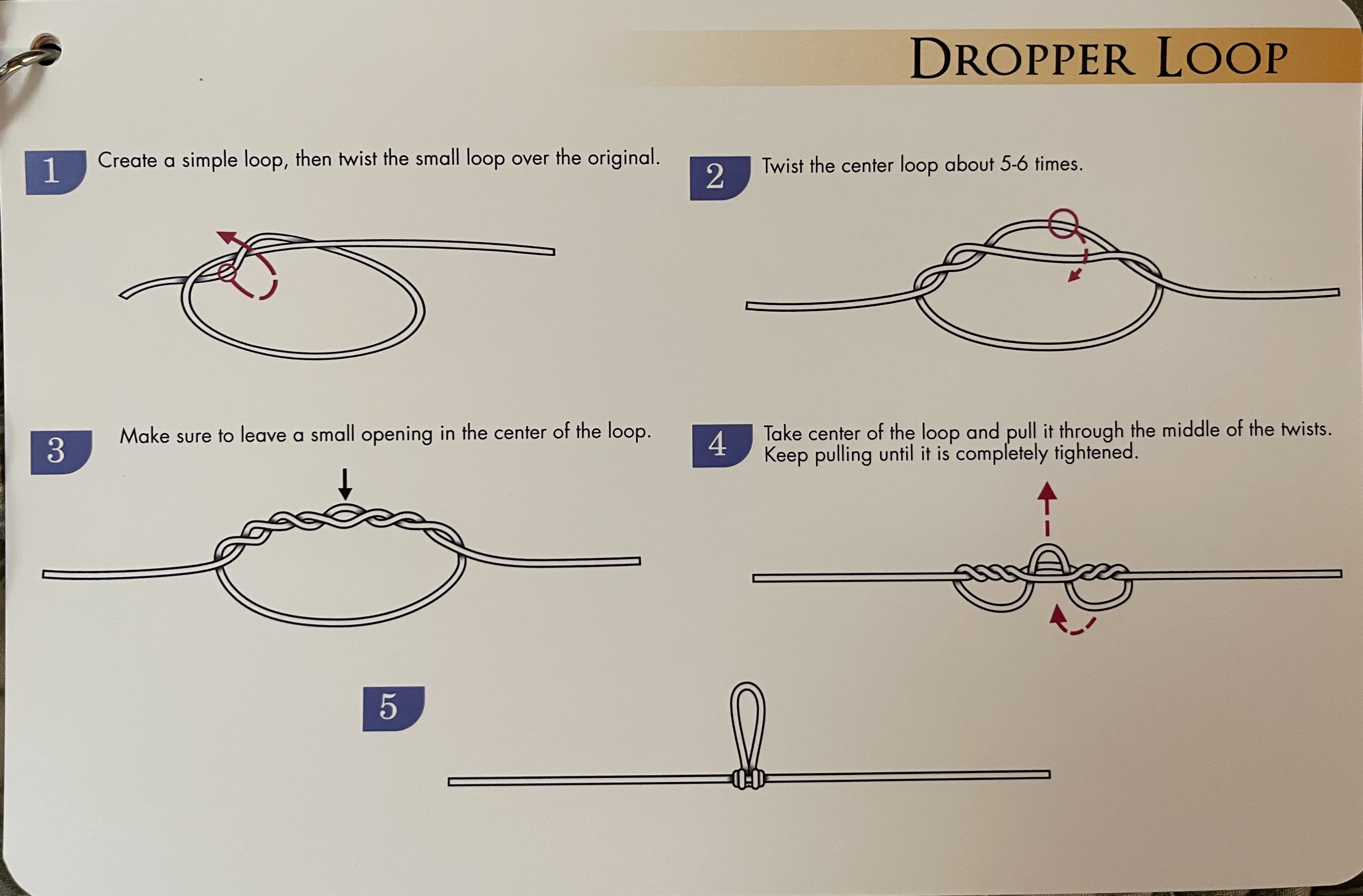
Summary
Purpose of the Dropper Loop Knot:
-
Attaching Multiple Hooks:
- It is commonly used in bottom fishing or jigging to create loops where you can attach multiple hooks along a single line.
- This allows you to fish with more than one bait at different depths, increasing your chances of a catch.
-
Holding Weights:
- A dropper loop can also be used to attach a weight if you need to sink your line faster or keep it steady in strong currents.
-
Improved Presentation:
- The loop holds hooks and bait away from the mainline, providing better movement and a more natural presentation, which can attract fish more effectively.
-
Strong and Durable:
- This knot is reliable, making it ideal for fishing situations where strength is critical, such as when targeting larger fish or fishing in rough waters.
Common Applications:
- Saltwater Fishing: For species like snapper, grouper, or cod, where multiple baited hooks are dropped to the ocean floor.
- Freshwater Fishing: For catching panfish, crappie, or trout when fishing in deeper lakes.
- Trolling or Drift Fishing: The loops allow multiple lures to be attached along the line for trolling at different depths.
How to Use the Dropper Loop Knot:
-
Set Up for Bottom Fishing Rigs:
- Tie one or more dropper loops along the line to attach baited hooks.
- Attach a sinker at the end of the line to keep it on the bottom.
-
Mid-Water Fishing:
- Create loops to suspend bait or lures at specific depths to target fish not near the surface or bottom.
-
Sabiki Rigs:
- Dropper loops are often used in pre-tied Sabiki rigs, which are designed for catching baitfish like mackerel or herring.
Final Summary
The Dropper Loop Knot is easy to tie, strong, and incredibly versatile, making it a must-know knot for anglers targeting a variety of species and environments.
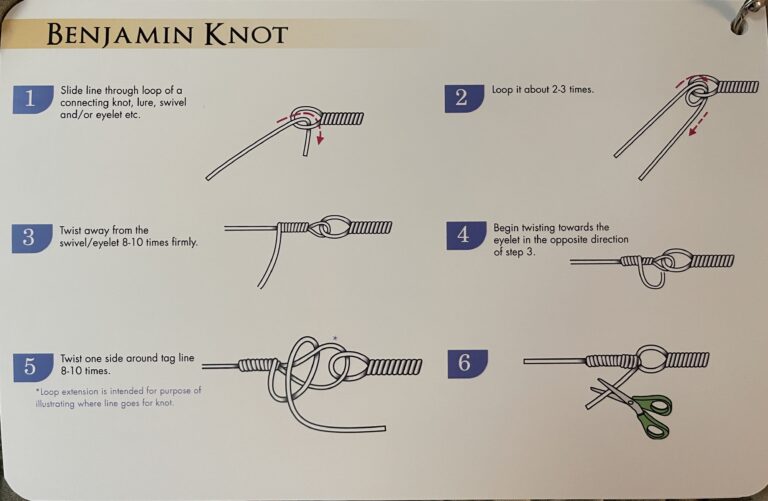
Summary
The Benjamin Knot is a relatively lesser-known but highly effective knot primarily used for tying braided fishing line to a monofilament or fluorocarbon leader. It is valued for its strength, streamlined profile, and ability to pass smoothly through rod guides.
Purpose of Benjamin Knot:
-
Connecting Braided Line to Leader:
- The Benjamin Knot is used to securely attach a braided mainline to a leader (usually monofilament or fluorocarbon).
- This setup combines the sensitivity and casting distance of braided line with the abrasion resistance and invisibility of monofilament/fluorocarbon.
-
Retaining Strength:
- The knot retains high line strength, making it ideal for situations where you need reliability under heavy loads (e.g., when targeting big fish).
-
Smooth Knot for Casting:
- The slim, low-profile design of the knot allows it to glide effortlessly through the guides of your rod during casting or retrieving.
Common Applications:
- Saltwater Fishing: Ideal for big game fish like tuna, marlin, or grouper, where a strong and streamlined knot is critical.
- Freshwater Fishing: Useful for connecting lines when fishing in rocky areas or around structure where leaders are needed to prevent break-offs.
- Fly Fishing: Sometimes used to create durable connections between fly lines and leaders.
Advantages of the Benjamin Knot:
- Strength: Offers excellent knot strength, even with lines of different diameters.
- Streamlined Profile: Reduces friction and bulk, enhancing casting performance.
- Durability: The knot resists slipping, even under heavy loads.
Final Summary
The Benjamin Knot is an excellent choice for anglers who value a strong, reliable, and smooth connection between their mainline and leader. It works well in various fishing scenarios, from casting inshore to trolling offshore.
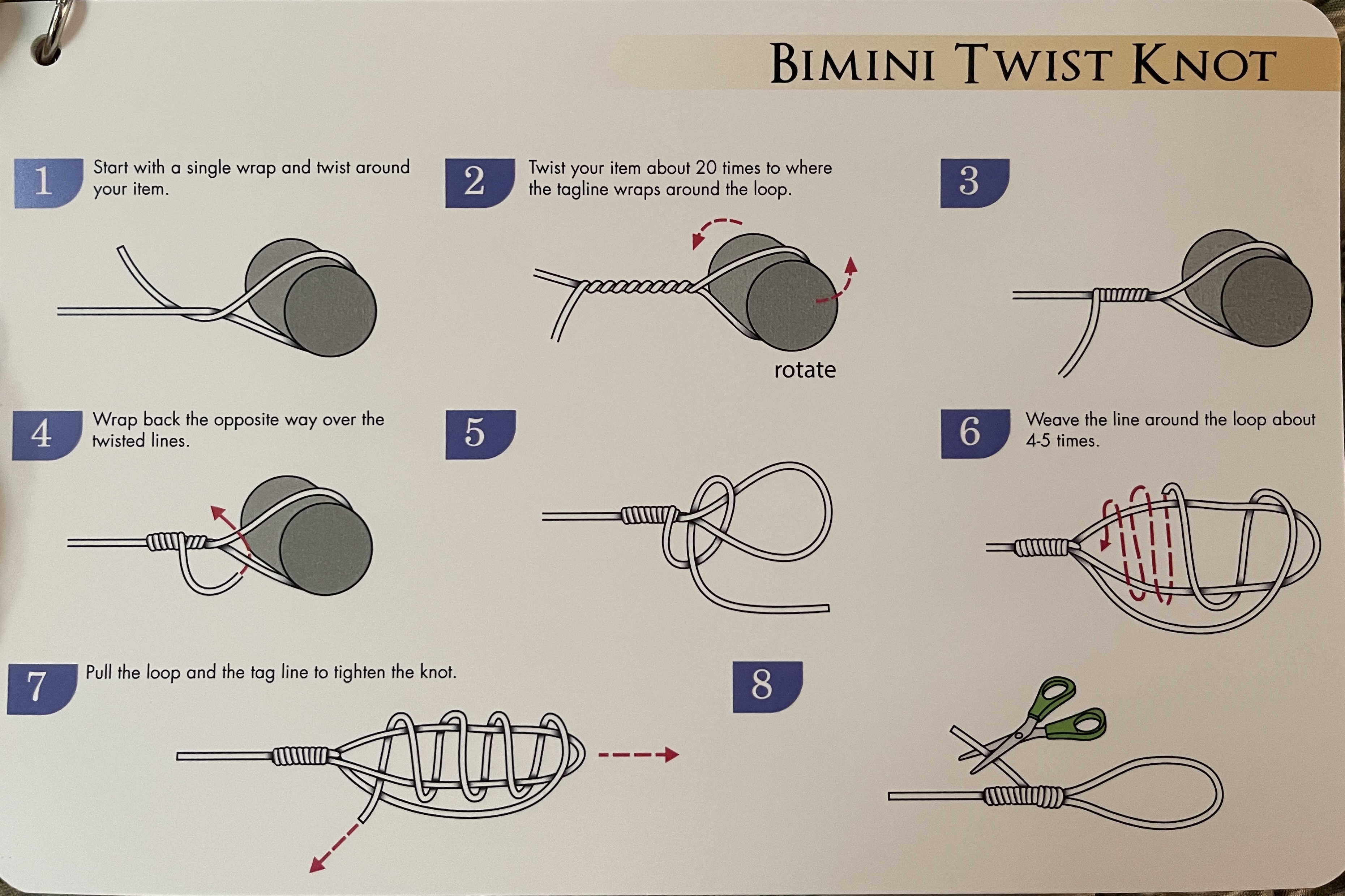
Summary
The Bimini Twist Knot is a strong, versatile knot used primarily in saltwater fishing. It creates a double line that provides extra strength, shock absorption, and abrasion resistance when targeting big, hard-fighting fish.
Purpose of the Bimini Twist Knot:
-
Creating a Double Line:
- The Bimini Twist forms a loop or double line at the end of your main fishing line, effectively doubling the line strength. This is particularly useful when connecting to leaders, hooks, or swivels.
-
Strength Retention:
- The knot retains close to 100% of the line’s original strength, making it ideal for heavy-duty fishing situations.
-
Shock Absorption:
- The double line created by the Bimini Twist absorbs the shock of powerful strikes or surging runs from large fish, reducing the chance of line breakage.
Common Applications:
-
Big Game Fishing:
- The Bimini Twist is a staple in offshore and saltwater fishing, especially when targeting species like tuna, marlin, sailfish, or tarpon.
- It is often used when trolling or live bait fishing with heavy tackle.
-
Connecting to Wind-On Leaders or Double Line Leaders:
- The double line created by the knot allows for a stronger, more secure connection to wind-on leaders or heavy monofilament leaders using knots like the Albright Knot or Loop-to-Loop Connection.
-
Fly Fishing for Saltwater Species:
- Used to create a strong loop at the end of a fly line backing for attaching to the main fly line.
-
IGFA (International Game Fish Association) Rules:
- The Bimini Twist is often used in tournament fishing to comply with IGFA rules that require double-line setups.
Final Summary
The Bimini Twist Knot is a must-know for serious saltwater anglers targeting trophy-sized fish, providing the extra security and strength needed in demanding fishing situations.
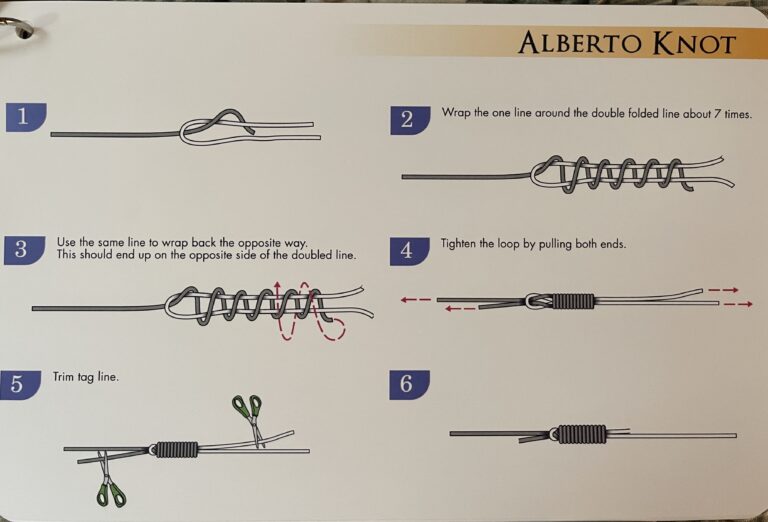
Summary
The Alberto Knot is a popular fishing knot used for connecting two lines of different diameters or materials. It is most commonly employed to connect a braided fishing line to a fluorocarbon or monofilament leader.
Purpose of the Alberto Knot:
-
Connecting Braided Line to Leader:
- The Alberto Knot excels at joining braided main lines to monofilament or fluorocarbon leaders. This combination is often used for finesse fishing techniques or when targeting species with sharp eyesight that require a more invisible leader.
-
Strong and Compact:
- The knot is known for its high strength and slim profile, which allows it to pass smoothly through rod guides without snagging.
Common Applications:
-
Saltwater and Freshwater Fishing:
- Widely used in both saltwater and freshwater fishing to connect braided line to a heavier or more abrasion-resistant leader.
-
Spinning and Casting Reels:
- Ideal for anglers using spinning or baitcasting reels, as its compact size minimizes interference during casting.
-
Techniques Requiring Long Leaders:
- Perfect for applications where a longer leader is necessary, such as:
- Surf Fishing: For casting long distances with a strong shock leader.
- Jigging: When using a leader to protect against abrasive structures or sharp fish teeth.
- Drop Shot or Finesse Fishing: In scenarios where a lighter, invisible fluorocarbon leader is advantageous.
- Perfect for applications where a longer leader is necessary, such as:
Advantages of the Alberto Knot:
-
Strong Connection:
- Provides a reliable, high-strength connection that can handle the strain of hard-fighting fish.
-
Low Profile:
- The slim design easily passes through rod guides, making it an excellent choice for long leaders.
-
Versatile:
- Works well with lines of varying diameters and materials (e.g., braid to mono or braid to fluoro).
-
Ease of Tying:
- Easier to learn and tie compared to other connection knots, such as the FG Knot, while still offering excellent strength.
Closing Summary
The Alberto Knot is favored by anglers for its balance of strength, simplicity, and versatility. Whether you’re targeting bass in freshwater or snook and redfish in saltwater, this knot is an essential tool for creating a strong and seamless line-to-leader connection.
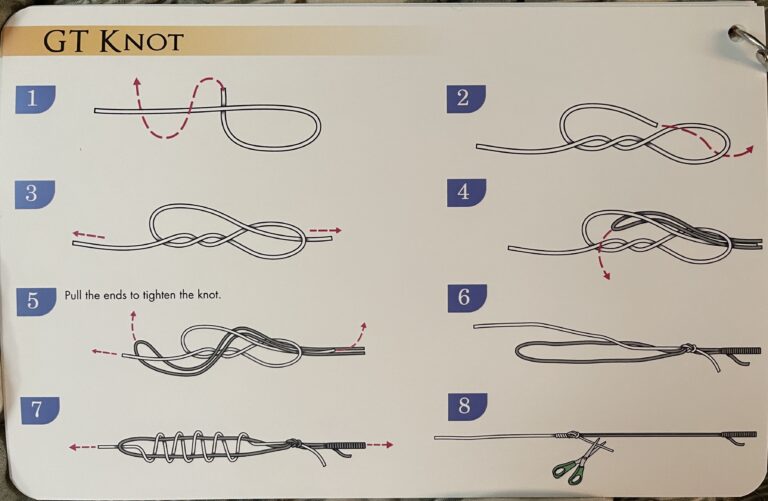
Summary
The GT Knot (short for Giant Trevally Knot) is a highly strong and reliable knot primarily used for connecting a braided fishing line to a monofilament or fluorocarbon leader. It is favored by anglers targeting large, powerful fish, especially in saltwater fishing.
Purpose of the GT Knot:
-
Connecting Braided Line to Heavy Leaders:
- The GT Knot is specifically designed for tying thick, heavy monofilament or fluorocarbon leaders (often 80-200 lb test) to thin braided lines.
- This setup is essential when targeting large fish where a strong leader is needed to handle abrasion and impact forces.
-
Withstanding Extreme Strain:
- The knot is incredibly strong, capable of withstanding the immense pressure and sudden bursts of energy from hard-fighting fish.
-
Streamlined for Casting:
- The slim and compact profile allows it to pass smoothly through rod guides, making it suitable for casting setups with long leaders.
Common Applications:
-
Saltwater Big Game Fishing:
- The GT Knot is widely used when targeting species like giant trevally, tuna, marlin, sailfish, or kingfish.
-
Popper and Jig Fishing:
- It’s a go-to knot for anglers using popping or jigging techniques, where the leader must withstand aggressive strikes and abrasive underwater structures.
-
Heavy Tackle Applications:
- Ideal for situations where heavy-duty tackle and a strong connection between the mainline and leader are critical.
Advantages of the GT Knot:
-
Incredible Strength:
- One of the strongest knots for connecting braid to leader, capable of handling extreme loads without slipping or breaking.
-
Abrasion Resistance:
- The GT Knot maintains the leader’s full strength and durability, crucial when fishing in rocky or coral-filled areas.
-
Slim Profile:
- Despite its strength, the knot’s slim design ensures smooth casting and prevents snagging on guides.
-
Durability:
- The GT Knot is highly resistant to wear and tear, making it suitable for prolonged battles with large fish.
Why Choose the GT Knot?
The GT Knot is a favorite among anglers fishing in demanding environments, particularly where large and powerful fish are involved. If you’re planning to fish offshore or in environments with heavy cover or sharp-toothed predators, the GT Knot ensures a secure and reliable connection between your braided line and leader. It’s a must-know knot for serious big-game anglers.
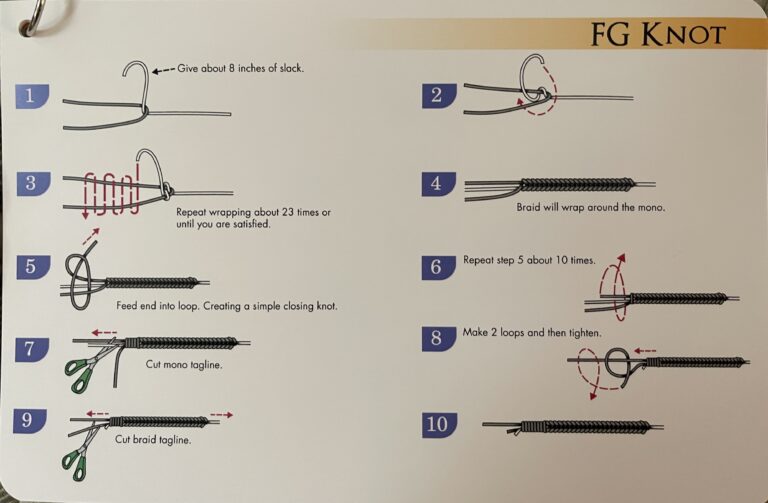
Summary
The FG Knot is widely regarded as one of the strongest and most efficient knots for connecting a braided fishing line to a monofilament or fluorocarbon leader. Its strength, slim profile, and durability make it a favorite among both freshwater and saltwater anglers.
Purpose of the FG Knot:
-
Connecting Braided Line to Leader:
- The FG Knot creates a direct connection by wrapping the braided line tightly around the leader without doubling the leader line. This ensures a strong, streamlined bond.
-
Strength and Efficiency:
- It retains close to 100% of the braided line’s original strength, making it ideal for high-stress situations.
-
Smooth Casting:
- Its slim, low-profile design passes smoothly through rod guides, reducing friction and ensuring long-distance casts.
Common Applications:
-
Saltwater Fishing:
- The FG Knot is especially useful for targeting powerful species like tuna, marlin, sailfish, giant trevally, and tarpon, where a heavy leader is needed.
-
Jigging and Popping:
- Frequently used in vertical jigging or when casting large poppers, where a strong, smooth knot is crucial to handle aggressive strikes.
-
Freshwater Fishing:
- Popular for bass fishing and finesse techniques requiring a strong yet discreet fluorocarbon leader.
-
Heavy Leaders:
- The FG Knot excels at connecting braided line to thick monofilament or fluorocarbon leaders, even when there’s a large difference in line diameter.
Advantages of the FG Knot:
-
Exceptional Strength:
- The FG Knot is considered the strongest braid-to-leader connection, capable of handling the force of large fish.
-
Slim Profile:
- Unlike bulkier knots, it lies flat, allowing smooth passage through rod guides without snagging or reducing casting distance.
-
Durability:
- The knot is highly resistant to slipping or breaking, even under heavy tension.
-
Improved Presentation:
- Its slim design minimizes disturbance in the water, making it ideal for stealthy presentations with a fluorocarbon leader.
Why Choose the FG Knot?
The FG Knot is an essential tool for any angler targeting larger fish or fishing in challenging environments. Its unparalleled strength and streamlined design make it the best choice for connecting braided mainlines to leaders, ensuring both reliability and optimal casting performance. If you’re serious about fishing, mastering the FG Knot is highly recommended.
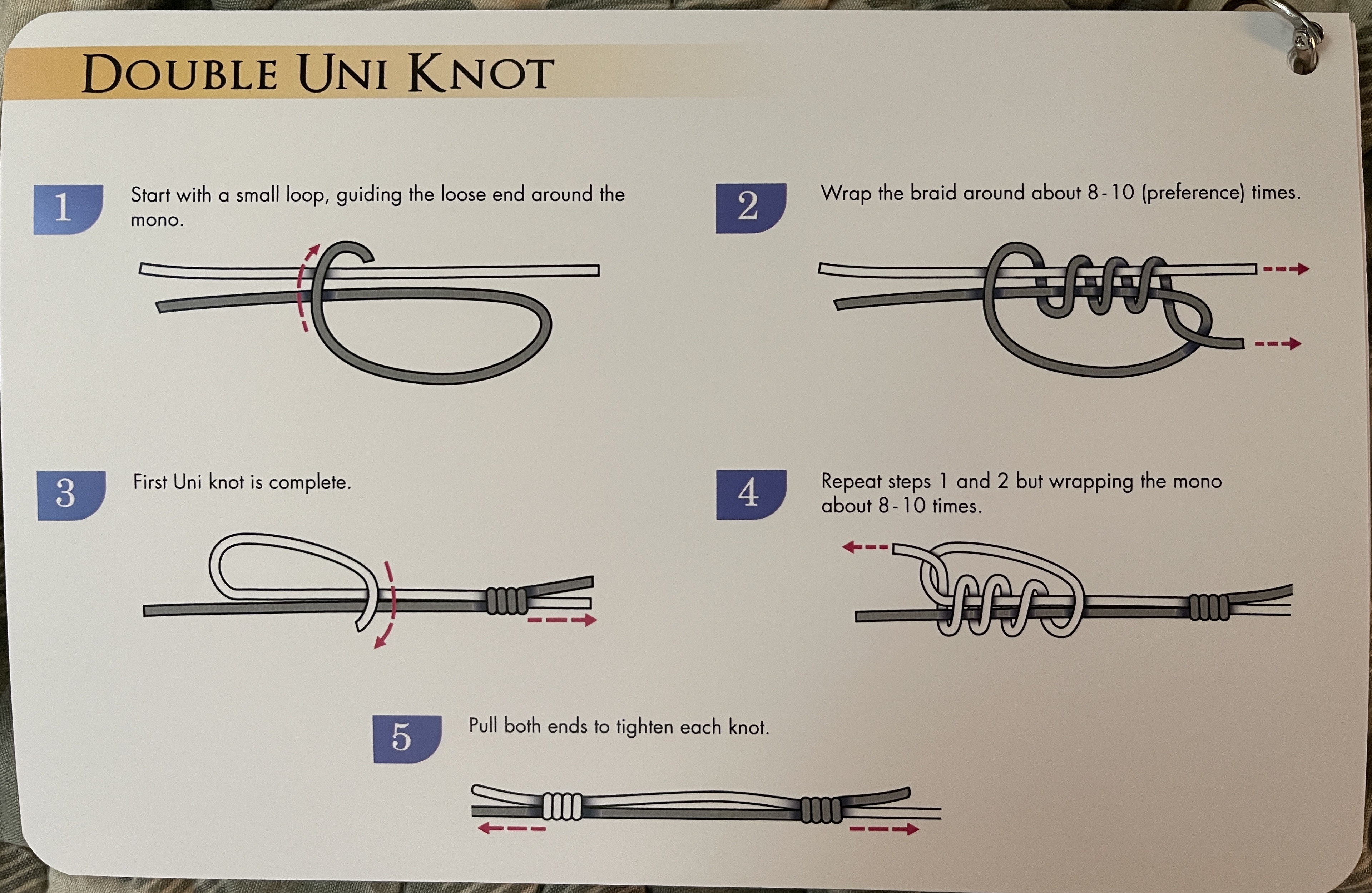
Summary
The Double Uni Knot is a versatile and reliable knot used to connect two fishing lines of similar or different diameters and materials. It is particularly popular for its ease of tying and strong, dependable hold.
Purpose of the Double Uni Knot:
-
Joining Two Lines:
- The Double Uni Knot is primarily used to join two fishing lines, such as a braided mainline to a monofilament or fluorocarbon leader.
- It works well for lines of different diameters or materials.
-
Versatility:
- It can be used for both saltwater and freshwater fishing.
- Effective in a variety of setups, from spinning reels to baitcasting setups.
-
Strong and Reliable Connection:
- The knot maintains excellent line strength, ensuring the connection holds up during fights with fish.
Common Applications:
-
Braid-to-Leader Connection:
- A popular choice for tying braided fishing lines to monofilament or fluorocarbon leaders in situations like finesse fishing or jigging.
-
Line-to-Line Repairs:
- Ideal for connecting two monofilament or fluorocarbon lines when extending or repairing a broken line.
-
Fly Fishing:
- Used to connect backing to fly line or fly line to leader.
-
General Fishing Use:
- Can be employed when creating multi-line rigs or tying leaders for trolling, casting, or jigging.
Advantages of the Double Uni Knot:
-
Ease of Tying:
- The knot is relatively simple to learn and tie, even in field conditions or low light.
-
Strong Connection:
- Provides high strength and durability, capable of withstanding significant tension.
-
Compact Profile:
- While slightly bulkier than some other knots (e.g., FG Knot), it still passes through rod guides smoothly, especially when tied correctly.
-
Versatile Across Materials:
- Works effectively with a variety of line types, including braid, mono, and fluoro.
Why Choose the Double Uni Knot?
The Double Uni Knot is an excellent all-around choice for line-to-line connections. Its balance of strength, simplicity, and reliability makes it a favorite among anglers of all experience levels. Whether you’re fishing freshwater for bass or saltwater for snapper, this knot provides a dependable connection for a wide range of fishing scenarios.
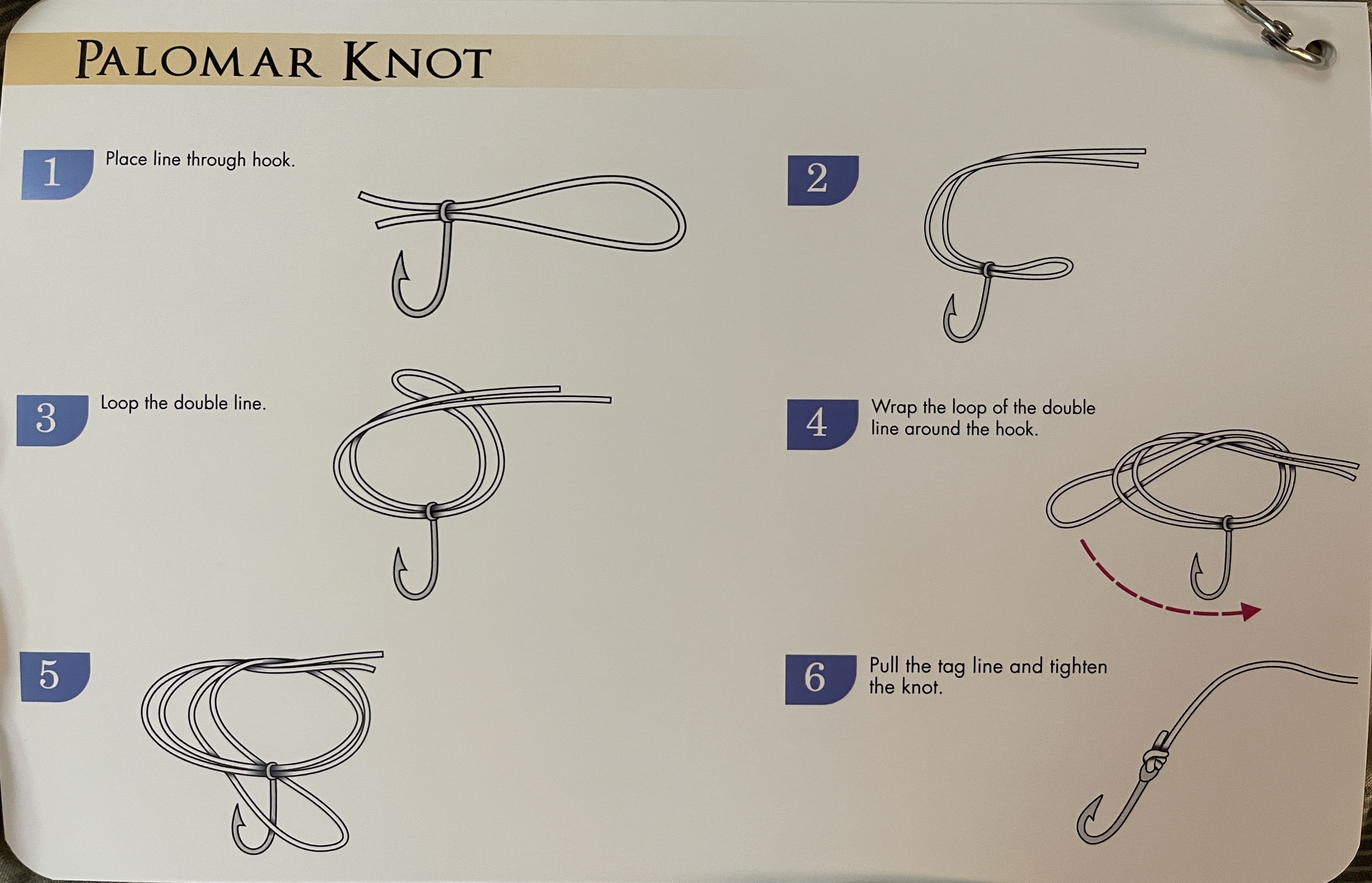
Summary
The Palomar Knot is one of the strongest and easiest fishing knots, widely used for securing a fishing line to a hook, lure, or swivel. Its simplicity and reliability make it a go-to knot for anglers of all skill levels.
Purpose of the Palomar Knot:
-
Tying a Line to a Hook or Lure:
- The Palomar Knot is ideal for attaching a hook, artificial lure, or swivel directly to the fishing line.
-
Strength and Simplicity:
- Known for its high knot strength (up to 95% of the line’s original strength) and quick tying process.
-
Versatile Applications:
- Effective with monofilament, fluorocarbon, and braided lines.
Common Applications
-
Bass Fishing:
- Frequently used to tie on soft plastic baits, jigs, or crankbaits.
- Its strong, secure hold ensures lures stay in place during aggressive strikes.
-
Fly Fishing:
- Can be used to attach a fly to the tippet for a secure and durable connection.
-
Saltwater Fishing:
- Excellent for tying hooks or lures in saltwater setups, where strength is critical.
-
Drop Shot Fishing:
- Often used in finesse techniques, such as drop shot rigs, where a loop can be left above the knot to hold the hook in a horizontal position.
Advantages of the Palomar Knot:
-
Exceptional Strength:
- Retains a high percentage of the line’s original strength, making it ideal for strong fish.
-
Easy to Tie:
- Quick and simple, even for beginners, and can be tied effectively in low-light or windy conditions.
-
Versatile:
- Works well with a variety of line types and fishing techniques.
-
Tangle-Free Design:
- The knot’s compact structure reduces the risk of tangles or snags.
Why Choose the Palomar Knot?
The Palomar Knot is a must-know for any angler due to its strength, reliability, and simplicity. Whether you’re targeting bass in freshwater or redfish in saltwater, this knot is an excellent choice for tying your line to hooks, lures, or swivels. It’s particularly effective in situations where a strong, no-slip connection is essential.
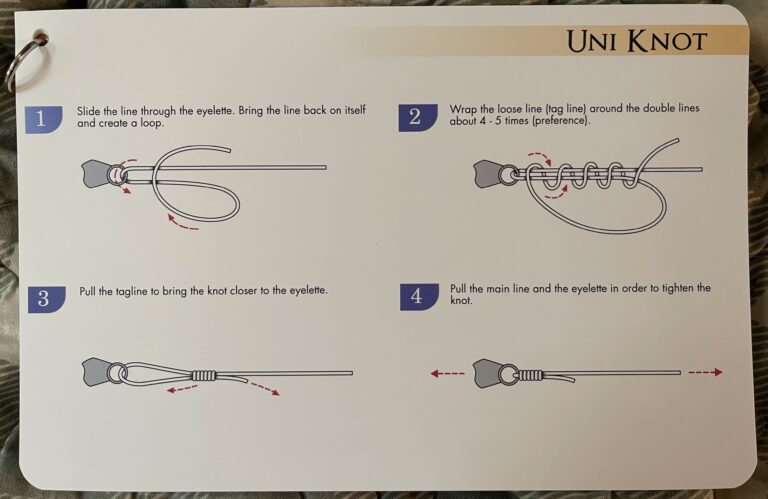
Summary
The Uni Knot is one of the most versatile and reliable fishing knots. Here’s how and where you would use it:
Primary Uses of a Uni Knot
-
Attaching a Hook, Lure, or Swivel to a Line:
- The Uni Knot is commonly used to securely tie a hook, lure, or swivel to your main fishing line or leader.
-
Joining Two Lines Together (Double Uni Knot):
- Ideal for connecting lines of different diameters or materials, such as:
- Braided line to monofilament or fluorocarbon leader.
- Two monofilament lines.
- Known for its strength and smoothness when passing through rod guides.
- Ideal for connecting lines of different diameters or materials, such as:
-
Creating a Snug Loop:
- By partially tightening the knot, it can slide down and snug up to an object, like a hook or swivel.
-
Sliding Knot for Adjustments:
- The Uni Knot can act as a sliding loop, allowing anglers to reposition the knot when needed, such as for slip bobbers.
Why Use the Uni Knot?
- Versatility:
- It works with monofilament, fluorocarbon, and braided fishing lines.
- Strength:
- Maintains a high percentage of the line’s breaking strength.
- Ease of Tying:
- Simple to learn and tie quickly, even in challenging conditions (e.g., low light or on a boat).
- Low Profile:
- Creates a neat and streamlined knot, which is less likely to snag or catch on rod guides.
Steps to Tie a Uni Knot
-
Pass the Line Through the Eye:
- Thread the line through the eye of the hook, swivel, or lure and double it back to create a loop.
-
Wrap the Line Around Itself:
- Take the tag end of the line and wrap it around both the main line and the loop 5-7 times.
-
Tighten the Wraps:
- Pull the tag end to snug the wraps tightly around the main line.
-
Slide and Secure:
- Pull the standing line to slide the knot down to the eye of the hook, swivel, or lure.
-
Trim the Tag End:
- Cut off any excess tag end to complete the knot.
When to Use the Uni Knot
-
Inshore and Offshore Fishing:
- Great for tying hooks and leaders in saltwater or freshwater environments.
-
Heavy and Light Lines:
- Works well for a variety of line strengths and diameters.
-
For Strength and Simplicity:
- When you need a quick, reliable, and strong knot.
By mastering the Uni Knot, you’ll have a go-to solution for a wide range of fishing needs!

Summary
The Improved Clinch Knot is a popular fishing knot used for securing a fishing line to a hook, lure, or swivel. Here’s a breakdown of its uses and benefits:
Reliability
The Improved Clinch Knot is a reliable and beginner-friendly knot, making it an excellent choice for most recreational anglers.
Primary Uses of an Improved Clinch Knot
-
Attaching a Hook, Lure, or Swivel:
- This knot is commonly used to tie a fishing line directly to the eye of a hook, lure, or swivel.
- It’s particularly popular for freshwater fishing and light saltwater applications.
-
Securing Terminal Tackle:
- Ideal for attaching terminal tackle, such as jigs, spinners, or crankbaits.
-
Tying to Monofilament or Fluorocarbon:
- Best suited for monofilament and fluorocarbon lines because of its ability to grip tightly.
Why Use the Improved Clinch Knot?
-
Strength:
- The “improved” aspect comes from passing the tag end through the loop at the end before tightening, increasing knot strength.
-
Ease of Tying:
- Simple to tie, even for beginners, and effective for most fishing situations.
-
Streamlined Design:
- The finished knot is small and neat, making it less likely to snag or tangle.
-
Versatility:
- Works well in a variety of fishing scenarios, especially when using light to medium tackle.
How to Tie an Improved Clinch Knot
-
Pass the Line Through the Eye:
- Thread the line through the eye of the hook or lure.
-
Wrap the Line:
- Wrap the tag end around the standing line 5–7 times.
-
Thread Through the Loop:
- Pass the tag end through the small loop near the eye.
-
Improved Step:
- Take the tag end and pass it through the large loop you just created.
-
Tighten the Knot:
- Moisten the knot with water or saliva to reduce friction, then pull the standing line to tighten the knot.
-
Trim the Tag End:
- Cut off any excess tag end close to the knot.
When to Use the Improved Clinch Knot
-
Light to Medium Line:
- Best suited for lines with a lower breaking strength (e.g., under 30 lbs). For heavier lines, the knot may lose efficiency.
-
Freshwater Fishing:
- Frequently used for bass, trout, and panfish fishing.
-
Calm Waters:
- Works well when not dealing with large, aggressive fish that may put extreme strain on the knot.
Limitations
-
Not Ideal for Braided Line:
- The knot may slip when used with slick braided fishing lines unless a drop of superglue is added or another knot is tied (like a Palomar Knot).
-
Strength Reduction:
- The knot reduces line strength slightly when improperly tied or over-tightened.

Summary
The Improved Clinch Knot is a popular fishing knot used for securing a fishing line to a hook, lure, or swivel. Here’s a breakdown of its uses and benefits:
Reliability
The Improved Clinch Knot is a reliable and beginner-friendly knot, making it an excellent choice for most recreational anglers.
Primary Uses of an Improved Clinch Knot
-
Attaching a Hook, Lure, or Swivel:
- This knot is commonly used to tie a fishing line directly to the eye of a hook, lure, or swivel.
- It’s particularly popular for freshwater fishing and light saltwater applications.
-
Securing Terminal Tackle:
- Ideal for attaching terminal tackle, such as jigs, spinners, or crankbaits.
-
Tying to Monofilament or Fluorocarbon:
- Best suited for monofilament and fluorocarbon lines because of its ability to grip tightly.
Why Use the Improved Clinch Knot?
-
Strength:
- The “improved” aspect comes from passing the tag end through the loop at the end before tightening, increasing knot strength.
-
Ease of Tying:
- Simple to tie, even for beginners, and effective for most fishing situations.
-
Streamlined Design:
- The finished knot is small and neat, making it less likely to snag or tangle.
- Works well in a variety of fishing scenarios, especially when using light to medium tackle.
- The finished knot is small and neat, making it less likely to snag or tangle.
How to Tie an Improved Clinch Knot
-
Pass the Line Through the Eye:
- Thread the line through the eye of the hook or lure.
-
Wrap the Line:
- Wrap the tag end around the standing line 5–7 times.
-
Thread Through the Loop:
- Pass the tag end through the small loop near the eye.
-
Improved Step:
- Take the tag end and pass it through the large loop you just created.
-
Tighten the Knot:
- Moisten the knot with water or saliva to reduce friction, then pull the standing line to tighten the knot.
-
Trim the Tag End:
- Cut off any excess tag end close to the knot.
When to Use the Improved Clinch Knot
-
Light to Medium Line:
- Best suited for lines with a lower breaking strength (e.g., under 30 lbs). For heavier lines, the knot may lose efficiency.
-
Freshwater Fishing:
- Frequently used for bass, trout, and panfish fishing.
-
Calm Waters:
- Works well when not dealing with large, aggressive fish that may put extreme strain on the knot.
Limitations
-
Not Ideal for Braided Line:
- The knot may slip when used with slick braided fishing lines unless a drop of superglue is added or another knot is tied (like a Palomar Knot).
-
Strength Reduction:
- The knot reduces line strength slightly when improperly tied or over-tightened.

Summary
The Haywire Twist Knot is a specialized knot used primarily in saltwater fishing when working with single-strand wire leaders. This knot is not technically a “knot” but a twisting technique to securely attach hooks, swivels, or lures to wire, preventing the sharp teeth of certain fish (like mackerel or barracuda) from cutting through the line.
Essebtial Tool for Saltwater
The Haywire Twist Knot is an essential tool for saltwater anglers targeting toothy predators. It ensures durability, secure attachments, and confidence when fishing in tough conditions where fish can destroy weaker leader setups.
Primary Uses of the Haywire Twist Knot
-
Attaching Wire Leaders to Hooks, Lures, or Swivels:
- Ideal for connecting hooks, trolling lures, or artificial baits when using single-strand wire leaders in saltwater fishing.
-
Fishing for Toothy Predators:
- Essential when targeting sharp-toothed fish like:
- Barracuda
- Kingfish (King Mackerel)
- Wahoo
- Bluefish
- Sharks These fish can easily bite through monofilament or fluorocarbon leaders, making wire leaders and the Haywire Twist essential.
- Essential when targeting sharp-toothed fish like:
-
Trolling Applications:
- Commonly used in offshore trolling rigs where fish strike fast-moving baits, and durability is critical.
Why Use the Haywire Twist Knot?
-
Secure Hold:
- The twisting action locks the wire leader securely to the hook, swivel, or lure, ensuring it won’t slip or loosen under tension.
-
Durability with Wire:
- Specifically designed for single-strand wire, which can be difficult to knot traditionally without weakening or kinking it.
-
Prevents Line Breakage:
- Protects against the sharp teeth of fish that would otherwise cut through softer leader materials.
-
Minimizes Weak Points:
- When done correctly, the twists distribute stress evenly along the wire, maintaining strength under heavy loads.
How to Tie the Haywire Twist Knot
-
Pass the Wire Through the Eye:
- Insert the wire through the eye of the hook, lure, or swivel, leaving about 6–8 inches of tag end.
-
Start Twisting:
- Hold the wire near the eye and begin wrapping the tag end around the standing wire in tight, uniform twists (4–6 twists). These twists lock the connection.
-
Barrel Wraps:
- After the twists, create 4–5 tight, barrel-style wraps by wrapping the tag end around the standing wire without overlapping. This strengthens the connection.
-
Break Off the Tag End:
- Bend the tag end back and forth sharply until it breaks off cleanly. Avoid cutting it, as sharp edges can injure hands or damage the line.
When to Use the Haywire Twist Knot
-
When Targeting Toothy Fish:
- Perfect for scenarios where you’re fishing in saltwater for species with sharp teeth.
-
In Offshore or Coastal Saltwater Fishing:
- Especially useful in trolling or live baiting setups where single-strand wire is needed.
-
For Heavier Fishing Applications:
- Works well when using larger hooks, lures, or baits that require a secure wire attachment.
Limitations of the Haywire Twist Knot
-
For Single-Strand Wire Only:
- Not suitable for braided wire or non-metal leaders like monofilament or fluorocarbon.
-
Requires Practice:
- The twisting and wrapping process takes practice to perfect, especially to make it neat and reliable.
-
Difficult to Untie:
- Once completed, the connection is permanent and can’t be undone without cutting the wire.

Summary
Purpose of the Dropper Loop Knot:
-
Attaching Multiple Hooks:
- It is commonly used in bottom fishing or jigging to create loops where you can attach multiple hooks along a single line.
- This allows you to fish with more than one bait at different depths, increasing your chances of a catch.
-
Holding Weights:
- A dropper loop can also be used to attach a weight if you need to sink your line faster or keep it steady in strong currents.
-
Improved Presentation:
- The loop holds hooks and bait away from the mainline, providing better movement and a more natural presentation, which can attract fish more effectively.
-
Strong and Durable:
- This knot is reliable, making it ideal for fishing situations where strength is critical, such as when targeting larger fish or fishing in rough waters.
Common Applications:
- Saltwater Fishing: For species like snapper, grouper, or cod, where multiple baited hooks are dropped to the ocean floor.
- Freshwater Fishing: For catching panfish, crappie, or trout when fishing in deeper lakes.
- Trolling or Drift Fishing: The loops allow multiple lures to be attached along the line for trolling at different depths.
How to Use the Dropper Loop Knot:
-
Set Up for Bottom Fishing Rigs:
- Tie one or more dropper loops along the line to attach baited hooks.
- Attach a sinker at the end of the line to keep it on the bottom.
-
Mid-Water Fishing:
- Create loops to suspend bait or lures at specific depths to target fish not near the surface or bottom.
-
Sabiki Rigs:
- Dropper loops are often used in pre-tied Sabiki rigs, which are designed for catching baitfish like mackerel or herring.
Final Summary
The Dropper Loop Knot is easy to tie, strong, and incredibly versatile, making it a must-know knot for anglers targeting a variety of species and environments.

Summary
The Benjamin Knot is a relatively lesser-known but highly effective knot primarily used for tying braided fishing line to a monofilament or fluorocarbon leader. It is valued for its strength, streamlined profile, and ability to pass smoothly through rod guides.
Purpose of Benjamin Knot:
-
Connecting Braided Line to Leader:
- The Benjamin Knot is used to securely attach a braided mainline to a leader (usually monofilament or fluorocarbon).
- This setup combines the sensitivity and casting distance of braided line with the abrasion resistance and invisibility of monofilament/fluorocarbon.
-
Retaining Strength:
- The knot retains high line strength, making it ideal for situations where you need reliability under heavy loads (e.g., when targeting big fish).
-
Smooth Knot for Casting:
- The slim, low-profile design of the knot allows it to glide effortlessly through the guides of your rod during casting or retrieving.
Common Applications:
- Saltwater Fishing: Ideal for big game fish like tuna, marlin, or grouper, where a strong and streamlined knot is critical.
- Freshwater Fishing: Useful for connecting lines when fishing in rocky areas or around structure where leaders are needed to prevent break-offs.
- Fly Fishing: Sometimes used to create durable connections between fly lines and leaders.
Advantages of the Benjamin Knot:
- Strength: Offers excellent knot strength, even with lines of different diameters.
- Streamlined Profile: Reduces friction and bulk, enhancing casting performance.
- Durability: The knot resists slipping, even under heavy loads.
Final Summary
The Benjamin Knot is an excellent choice for anglers who value a strong, reliable, and smooth connection between their mainline and leader. It works well in various fishing scenarios, from casting inshore to trolling offshore.

Summary
The Bimini Twist Knot is a strong, versatile knot used primarily in saltwater fishing. It creates a double line that provides extra strength, shock absorption, and abrasion resistance when targeting big, hard-fighting fish.
Purpose of the Bimini Twist Knot:
-
Creating a Double Line:
- The Bimini Twist forms a loop or double line at the end of your main fishing line, effectively doubling the line strength. This is particularly useful when connecting to leaders, hooks, or swivels.
-
Strength Retention:
- The knot retains close to 100% of the line’s original strength, making it ideal for heavy-duty fishing situations.
-
Shock Absorption:
- The double line created by the Bimini Twist absorbs the shock of powerful strikes or surging runs from large fish, reducing the chance of line breakage.
Common Applications:
-
Big Game Fishing:
- The Bimini Twist is a staple in offshore and saltwater fishing, especially when targeting species like tuna, marlin, sailfish, or tarpon.
- It is often used when trolling or live bait fishing with heavy tackle.
-
Connecting to Wind-On Leaders or Double Line Leaders:
- The double line created by the knot allows for a stronger, more secure connection to wind-on leaders or heavy monofilament leaders using knots like the Albright Knot or Loop-to-Loop Connection.
-
Fly Fishing for Saltwater Species:
- Used to create a strong loop at the end of a fly line backing for attaching to the main fly line.
-
IGFA (International Game Fish Association) Rules:
- The Bimini Twist is often used in tournament fishing to comply with IGFA rules that require double-line setups.
Final Summary
The Bimini Twist Knot is a must-know for serious saltwater anglers targeting trophy-sized fish, providing the extra security and strength needed in demanding fishing situations.

Summary
The Alberto Knot is a popular fishing knot used for connecting two lines of different diameters or materials. It is most commonly employed to connect a braided fishing line to a fluorocarbon or monofilament leader.
Purpose of the Alberto Knot:
-
Connecting Braided Line to Leader:
- The Alberto Knot excels at joining braided main lines to monofilament or fluorocarbon leaders. This combination is often used for finesse fishing techniques or when targeting species with sharp eyesight that require a more invisible leader.
-
Strong and Compact:
- The knot is known for its high strength and slim profile, which allows it to pass smoothly through rod guides without snagging.
Common Applications:
-
Saltwater and Freshwater Fishing:
- Widely used in both saltwater and freshwater fishing to connect braided line to a heavier or more abrasion-resistant leader.
-
Spinning and Casting Reels:
- Ideal for anglers using spinning or baitcasting reels, as its compact size minimizes interference during casting.
-
Techniques Requiring Long Leaders:
- Perfect for applications where a longer leader is necessary, such as:
- Surf Fishing: For casting long distances with a strong shock leader.
- Jigging: When using a leader to protect against abrasive structures or sharp fish teeth.
- Drop Shot or Finesse Fishing: In scenarios where a lighter, invisible fluorocarbon leader is advantageous.
- Perfect for applications where a longer leader is necessary, such as:
Advantages of the Alberto Knot:
-
Strong Connection:
- Provides a reliable, high-strength connection that can handle the strain of hard-fighting fish.
-
Low Profile:
- The slim design easily passes through rod guides, making it an excellent choice for long leaders.
-
Versatile:
- Works well with lines of varying diameters and materials (e.g., braid to mono or braid to fluoro).
-
Ease of Tying:
- Easier to learn and tie compared to other connection knots, such as the FG Knot, while still offering excellent strength.
Closing Summary
The Alberto Knot is favored by anglers for its balance of strength, simplicity, and versatility. Whether you’re targeting bass in freshwater or snook and redfish in saltwater, this knot is an essential tool for creating a strong and seamless line-to-leader connection.

Summary
The GT Knot (short for Giant Trevally Knot) is a highly strong and reliable knot primarily used for connecting a braided fishing line to a monofilament or fluorocarbon leader. It is favored by anglers targeting large, powerful fish, especially in saltwater fishing.
Purpose of the GT Knot:
-
Connecting Braided Line to Heavy Leaders:
- The GT Knot is specifically designed for tying thick, heavy monofilament or fluorocarbon leaders (often 80-200 lb test) to thin braided lines.
- This setup is essential when targeting large fish where a strong leader is needed to handle abrasion and impact forces.
-
Withstanding Extreme Strain:
- The knot is incredibly strong, capable of withstanding the immense pressure and sudden bursts of energy from hard-fighting fish.
-
Streamlined for Casting:
- The slim and compact profile allows it to pass smoothly through rod guides, making it suitable for casting setups with long leaders.
Common Applications:
-
Saltwater Big Game Fishing:
- The GT Knot is widely used when targeting species like giant trevally, tuna, marlin, sailfish, or kingfish.
-
Popper and Jig Fishing:
- It’s a go-to knot for anglers using popping or jigging techniques, where the leader must withstand aggressive strikes and abrasive underwater structures.
-
Heavy Tackle Applications:
- Ideal for situations where heavy-duty tackle and a strong connection between the mainline and leader are critical.
Advantages of the GT Knot:
-
Incredible Strength:
- One of the strongest knots for connecting braid to leader, capable of handling extreme loads without slipping or breaking.
-
Abrasion Resistance:
- The GT Knot maintains the leader’s full strength and durability, crucial when fishing in rocky or coral-filled areas.
-
Slim Profile:
- Despite its strength, the knot’s slim design ensures smooth casting and prevents snagging on guides.
-
Durability:
- The GT Knot is highly resistant to wear and tear, making it suitable for prolonged battles with large fish.
Why Choose the GT Knot?
The GT Knot is a favorite among anglers fishing in demanding environments, particularly where large and powerful fish are involved. If you’re planning to fish offshore or in environments with heavy cover or sharp-toothed predators, the GT Knot ensures a secure and reliable connection between your braided line and leader. It’s a must-know knot for serious big-game anglers.

Summary
The FG Knot is widely regarded as one of the strongest and most efficient knots for connecting a braided fishing line to a monofilament or fluorocarbon leader. Its strength, slim profile, and durability make it a favorite among both freshwater and saltwater anglers.
Purpose of the FG Knot:
-
Connecting Braided Line to Leader:
- The FG Knot creates a direct connection by wrapping the braided line tightly around the leader without doubling the leader line. This ensures a strong, streamlined bond.
-
Strength and Efficiency:
- It retains close to 100% of the braided line’s original strength, making it ideal for high-stress situations.
-
Smooth Casting:
- Its slim, low-profile design passes smoothly through rod guides, reducing friction and ensuring long-distance casts.
Common Applications:
-
Saltwater Fishing:
- The FG Knot is especially useful for targeting powerful species like tuna, marlin, sailfish, giant trevally, and tarpon, where a heavy leader is needed.
-
Jigging and Popping:
- Frequently used in vertical jigging or when casting large poppers, where a strong, smooth knot is crucial to handle aggressive strikes.
-
Freshwater Fishing:
- Popular for bass fishing and finesse techniques requiring a strong yet discreet fluorocarbon leader.
-
Heavy Leaders:
- The FG Knot excels at connecting braided line to thick monofilament or fluorocarbon leaders, even when there’s a large difference in line diameter.
Advantages of the FG Knot:
-
Exceptional Strength:
- The FG Knot is considered the strongest braid-to-leader connection, capable of handling the force of large fish.
-
Slim Profile:
- Unlike bulkier knots, it lies flat, allowing smooth passage through rod guides without snagging or reducing casting distance.
-
Durability:
- The knot is highly resistant to slipping or breaking, even under heavy tension.
-
Improved Presentation:
- Its slim design minimizes disturbance in the water, making it ideal for stealthy presentations with a fluorocarbon leader.
Why Choose the FG Knot?
The FG Knot is an essential tool for any angler targeting larger fish or fishing in challenging environments. Its unparalleled strength and streamlined design make it the best choice for connecting braided mainlines to leaders, ensuring both reliability and optimal casting performance. If you’re serious about fishing, mastering the FG Knot is highly recommended.

Summary
The Double Uni Knot is a versatile and reliable knot used to connect two fishing lines of similar or different diameters and materials. It is particularly popular for its ease of tying and strong, dependable hold.
Purpose of the Double Uni Knot:
-
Joining Two Lines:
- The Double Uni Knot is primarily used to join two fishing lines, such as a braided mainline to a monofilament or fluorocarbon leader.
- It works well for lines of different diameters or materials.
-
Versatility:
- It can be used for both saltwater and freshwater fishing.
- Effective in a variety of setups, from spinning reels to baitcasting setups.
-
Strong and Reliable Connection:
- The knot maintains excellent line strength, ensuring the connection holds up during fights with fish.
Common Applications:
-
Braid-to-Leader Connection:
- A popular choice for tying braided fishing lines to monofilament or fluorocarbon leaders in situations like finesse fishing or jigging.
-
Line-to-Line Repairs:
- Ideal for connecting two monofilament or fluorocarbon lines when extending or repairing a broken line.
-
Fly Fishing:
- Used to connect backing to fly line or fly line to leader.
-
General Fishing Use:
- Can be employed when creating multi-line rigs or tying leaders for trolling, casting, or jigging.
Advantages of the Double Uni Knot:
-
Ease of Tying:
- The knot is relatively simple to learn and tie, even in field conditions or low light.
-
Strong Connection:
- Provides high strength and durability, capable of withstanding significant tension.
-
Compact Profile:
- While slightly bulkier than some other knots (e.g., FG Knot), it still passes through rod guides smoothly, especially when tied correctly.
-
Versatile Across Materials:
- Works effectively with a variety of line types, including braid, mono, and fluoro.
Why Choose the Double Uni Knot?
The Double Uni Knot is an excellent all-around choice for line-to-line connections. Its balance of strength, simplicity, and reliability makes it a favorite among anglers of all experience levels. Whether you’re fishing freshwater for bass or saltwater for snapper, this knot provides a dependable connection for a wide range of fishing scenarios.

Summary
The Palomar Knot is one of the strongest and easiest fishing knots, widely used for securing a fishing line to a hook, lure, or swivel. Its simplicity and reliability make it a go-to knot for anglers of all skill levels.
Purpose of the Palomar Knot:
-
Tying a Line to a Hook or Lure:
- The Palomar Knot is ideal for attaching a hook, artificial lure, or swivel directly to the fishing line.
-
Strength and Simplicity:
- Known for its high knot strength (up to 95% of the line’s original strength) and quick tying process.
-
Versatile Applications:
- Effective with monofilament, fluorocarbon, and braided lines.
Common Applications
-
Bass Fishing:
- Frequently used to tie on soft plastic baits, jigs, or crankbaits.
- Its strong, secure hold ensures lures stay in place during aggressive strikes.
-
Fly Fishing:
- Can be used to attach a fly to the tippet for a secure and durable connection.
-
Saltwater Fishing:
- Excellent for tying hooks or lures in saltwater setups, where strength is critical.
-
Drop Shot Fishing:
- Often used in finesse techniques, such as drop shot rigs, where a loop can be left above the knot to hold the hook in a horizontal position.
Advantages of the Palomar Knot:
-
Exceptional Strength:
- Retains a high percentage of the line’s original strength, making it ideal for strong fish.
-
Easy to Tie:
- Quick and simple, even for beginners, and can be tied effectively in low-light or windy conditions.
-
Versatile:
- Works well with a variety of line types and fishing techniques.
-
Tangle-Free Design:
- The knot’s compact structure reduces the risk of tangles or snags.
Why Choose the Palomar Knot?
The Palomar Knot is a must-know for any angler due to its strength, reliability, and simplicity. Whether you’re targeting bass in freshwater or redfish in saltwater, this knot is an excellent choice for tying your line to hooks, lures, or swivels. It’s particularly effective in situations where a strong, no-slip connection is essential.

Summary
The Uni Knot is one of the most versatile and reliable fishing knots. Here’s how and where you would use it:
Primary Uses of a Uni Knot
-
Attaching a Hook, Lure, or Swivel to a Line:
- The Uni Knot is commonly used to securely tie a hook, lure, or swivel to your main fishing line or leader.
-
Joining Two Lines Together (Double Uni Knot):
- Ideal for connecting lines of different diameters or materials, such as:
- Braided line to monofilament or fluorocarbon leader.
- Two monofilament lines.
- Known for its strength and smoothness when passing through rod guides.
- Ideal for connecting lines of different diameters or materials, such as:
-
Creating a Snug Loop:
- By partially tightening the knot, it can slide down and snug up to an object, like a hook or swivel.
-
Sliding Knot for Adjustments:
- The Uni Knot can act as a sliding loop, allowing anglers to reposition the knot when needed, such as for slip bobbers.
Why Use the Uni Knot?
- Versatility:
- It works with monofilament, fluorocarbon, and braided fishing lines.
- Strength:
- Maintains a high percentage of the line’s breaking strength.
- Ease of Tying:
- Simple to learn and tie quickly, even in challenging conditions (e.g., low light or on a boat).
- Low Profile:
- Creates a neat and streamlined knot, which is less likely to snag or catch on rod guides.
Steps to Tie a Uni Knot
-
Pass the Line Through the Eye:
- Thread the line through the eye of the hook, swivel, or lure and double it back to create a loop.
-
Wrap the Line Around Itself:
- Take the tag end of the line and wrap it around both the main line and the loop 5-7 times.
-
Tighten the Wraps:
- Pull the tag end to snug the wraps tightly around the main line.
-
Slide and Secure:
- Pull the standing line to slide the knot down to the eye of the hook, swivel, or lure.
-
Trim the Tag End:
- Cut off any excess tag end to complete the knot.
When to Use the Uni Knot
-
Inshore and Offshore Fishing:
- Great for tying hooks and leaders in saltwater or freshwater environments.
-
Heavy and Light Lines:
- Works well for a variety of line strengths and diameters.
-
For Strength and Simplicity:
- When you need a quick, reliable, and strong knot.
By mastering the Uni Knot, you’ll have a go-to solution for a wide range of fishing needs!
The Dropper Loop Knot is a versatile knot used primarily in fishing to create a loop along your fishing line. This loop serves as an attachment point for additional hooks, bait, or weights. Here’s how and why you would use it:
